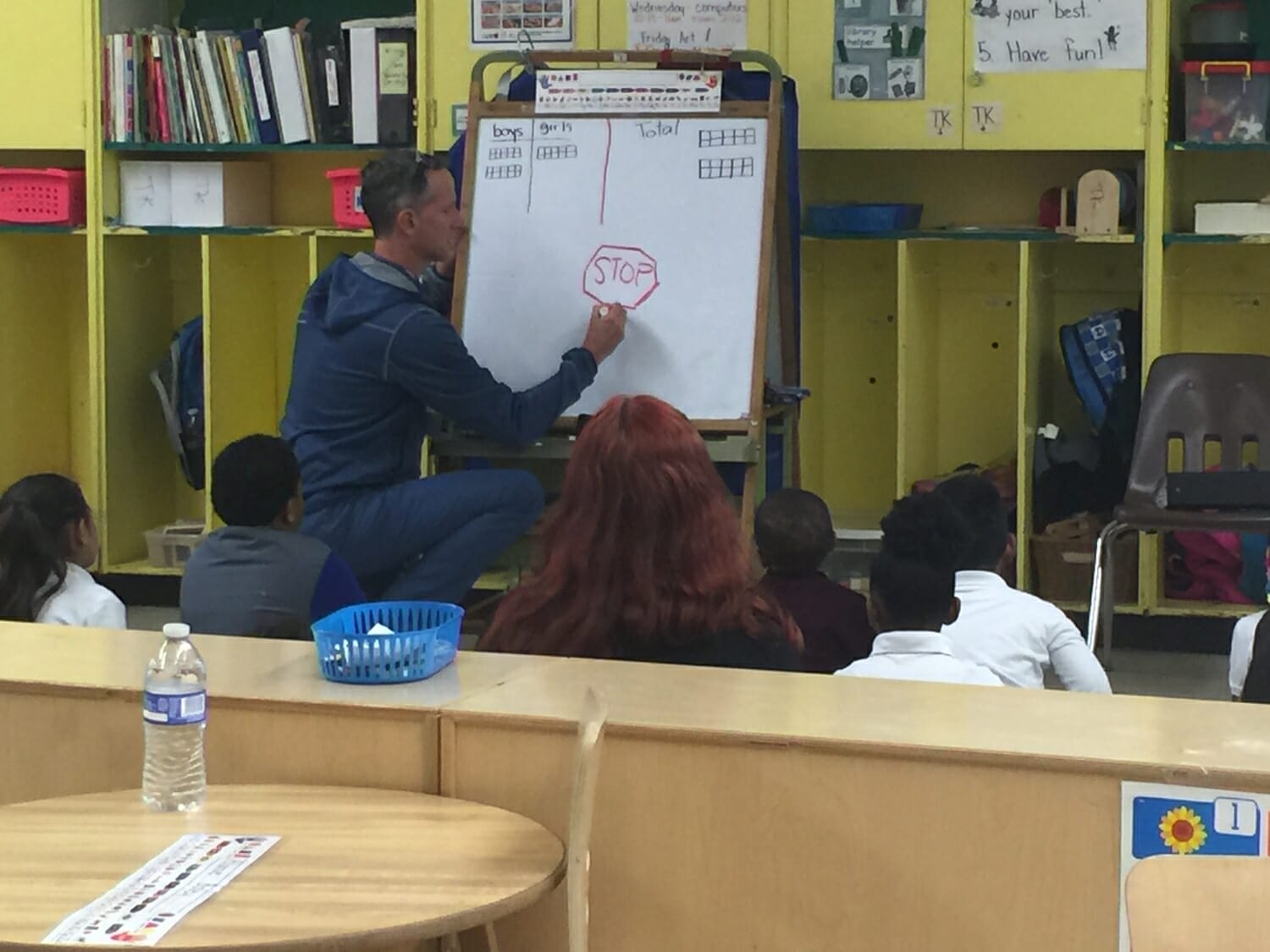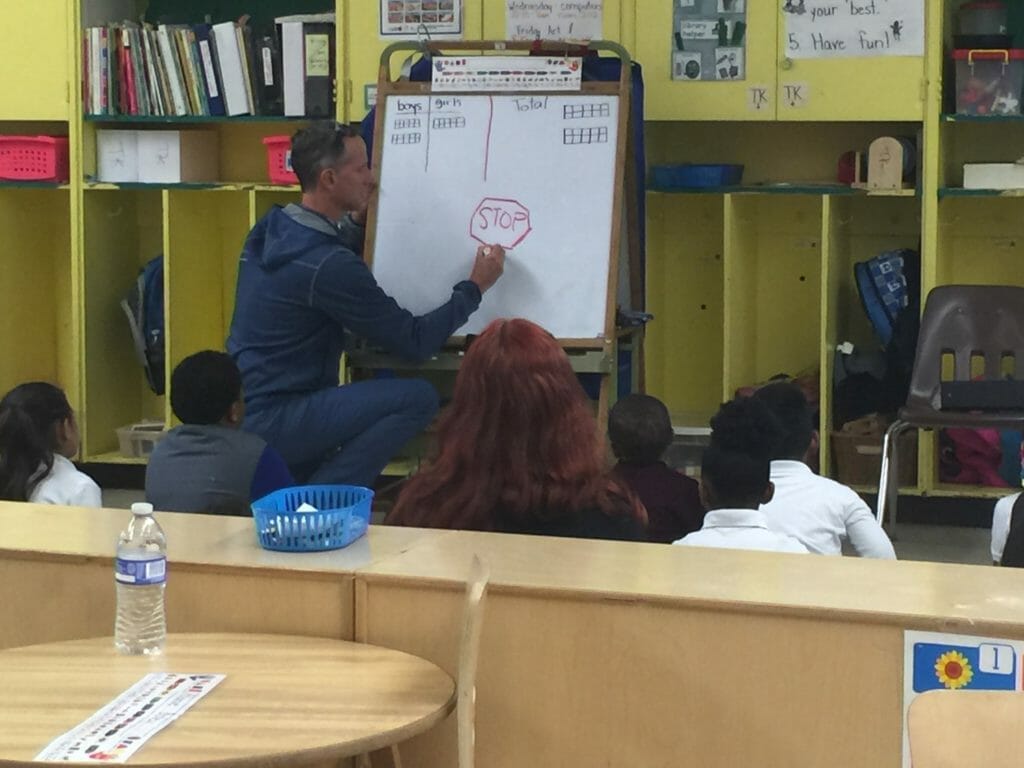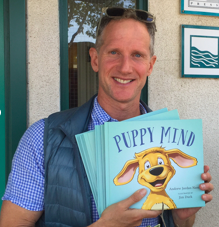Theater Veteran Teaches Kids Mindfulness in His Second Act


As a career thespian, Andrew Nance had no idea that he’d been engaging in the age-old practice of “mindfulness” throughout his entire adult life. It wasn’t until after he left his theater work to embark on another adventure that he discovered the tie between his theatrical endeavors and the mind-calming behavior.
Today, through his volunteer efforts with the San Francisco Education Fund, Andrew runs Mindful Arts San Francisco, a mindfulness program for students ages 4 to 11 years old. With each session, he teaches the students to focus and be in the moment. It’s an effort, he said, to help them learn to control their actions and emotions, particularly during stressful times.
Points of Light talked with Andrew about why he volunteers and the benefits his work brings to young children.
Why did you want to get involved with the San Francisco Education Fund and teach mindfulness in the classroom?
I’d been running a theater school for almost 20 years called The New Conservatory Theater Center. Around the 18th year, I decided I needed a new chapter in my life. I left the theater, and I started taking classes in positive psychology, life coaching, and various sorts of self-help classes as a way to stimulate and spark that fuel in all of us that ignites when we find something we really love to do.
I took a week-long teachers’ symposium at the Greater Good Science Center at UC Berkeley. They train teachers how to help students have better self care, as well as teach the teachers how to have self care. There was an organization there called Mindful School, and they started playing theater games with us to convey the principles of mindfulness. That was a huge moment for me because I realized I’d been studying mindfulness for 30 years with my theater background.
In that moment, I decided this is the journey I wanted to go on. And, I signed up for Mindful School’s online curriculum training and very quickly found two classrooms to test out mindfulness training. I didn’t feel like I was an expert, but these were kindergarteners. I went in and I thought I had one really successful class and one mediocre class at two different schools.

Describe what you do and the benefits it provides to participants.
I work with 4-year-olds to 11-year-olds, and we go in and check in with the kids. How are they feeling physically? We ask them to do a thumb gauge – thumbs up for good, down for bad, middle for feeling so-so. We ask how they’re feeling mentally and emotionally. Then, we ask them to do focus time. That’s sitting quietly for anywhere between 1 minute to 3-to-5 minutes, depending upon the age of the participant. What that allows them to do is learn to notice their brain’s desire to be reactive. Just witness all those jumbles of thoughts flying past them at light speed and not to reach out to try and grab them, but to just let them pass by.
We’re reminding them they have the habit of grasping on to every thought that floats by. But, I’m trying to teach them that thoughts are just a suggestion. We don’t have to act on every thought we have. Then, we either read them an original story I’ve written–there are 13 stories in all of the curriculum–or we play a theater game that is mindfully-based. We have a question and answer period about the story or the game and how they see the concepts in the story or in the game in their own lives. One story might be about the value of taking deep breaths throughout the day or the value of noticing our emotions or what we’re hearing right now. It could be able the value of noticing what we’re able to feel right now and how we can be kinder and more compassionate to ourselves and others.
How do the children respond?
Their reaction depends on the day. Some kids can focus every time I’m there. Some kids can’t focus. In that moment, I ask them to just notice their minds and their bodies. If your puppy mind is wandering off, just notice it and come back to your breath. Sometimes that really helps. Other days there’s so much trauma in their minds from what might have happened earlier in the day or worried about what might happen that it’s really had for them to feel safe enough to do this work. But, mostly, they’re very receptive to the idea that they can calm their minds.
How is the program structured?
I have 20 volunteers that I work with now. I’ve created this program called Mindful Arts San Fransisco. Over two years, I’ve gathered the volunteers that go into the classroom once a week for 30 minutes. They go into two classrooms when they’re at the school, so they’re there for one hour a week.
Basically, I reach out to the school that is nearest to a volunteer’s home or office or is centrally-located to their lives. I want to keep our volunteers as long as possible, so I try to make it as convenient as I can for them. So, often, they get to walk to the school of their choice. Most of the time, a school is interested in us bringing in a free program, but it doesn’t always work that way. Eighty-five percent of the time, there’s one teacher in that school who’s interested. I usually reach out to social workers at the site or the principal. Or, I have a contact teacher already lined up, so I’ll just reach out to them.
With my volunteers, I look for someone with some sort of mindfulness practice. It could be a yoga teacher, a therapist, ex-trial lawyer or doctor. They must have some sort of mindfulness practice in order to do this work. I don’t have the time to train people to be mindful, but I do have the time to teach them how to use the curriculum. They come in the fall or winter and take a 4-hour training that gives them a really great overview of how to use the curriculum in the most effective way.
What do you find the most rewarding about this activity?
I get huge benefits from it. It’s just a great practice for me to go into the classroom and try to be my most self-regulated self in a classroom that may or may not be ready to sit for an extended period of time. The other amazing thing to watch is the kids using the curriculum on their own. I’ve seen them walking down the hall doing Spider-Man breathing or Quiet Coyote breathing or drawing their puppy for their puppy minds. At one point, there was a fire drill at the school, and I happened to walk by a few classrooms. Both of the teachers were using mindfulness practices as a way to keep kids calm and focused as they left the school in a single file line. I’ve seen teachers use the mindfulness work that we bring to the kids when they’re having tantrums. Therapists at the school say many of the kids who have a really hard time self-regulating end of regulating quickly by using breathing techniques. It gives me chills to think about it. We’re changing kids’ life trajectories. I know people who have wound up in prison, and all of them say to me, “I did one dumb thing when I was 18 or 19, and now I’m here.” If we can teach people to be less reactive and more responsive, we literally can change lives. That’s what fuels me – it’s the idea that I can help one or more of these kids make better choices.
How does volunteering make you feel?
Volunteering lifts me up. It fuels me and makes me smile. It makes me try to bring my best, my most curious self to the work because the stakes are that high in my mind.
Do you have plans for future efforts?
I’d like to see Mindful Arts San Fransisco grow in a very thoughtful, careful way. I actually think it could be so big that it might need a program manager who is salaried because there are a lot of nuts and bolts and things to think about. It certainly is a replicable model that can be used in other places. I’m open to that, as well. But, really my main concern is quality and making sure the kids’ needs are met.
What do you hope people will remember about your story?
I hope that people follow their own desires to give back to their communities to whatever passions are within them. The rewards are so many and so rich.
This interview has been edited and condensed.